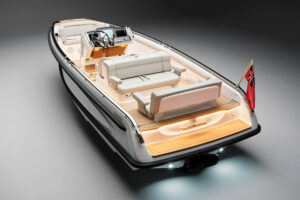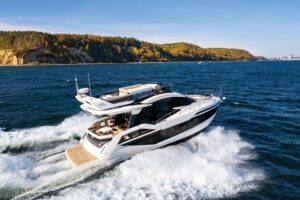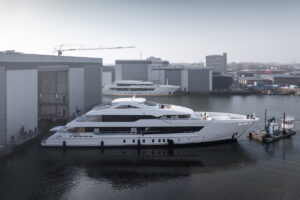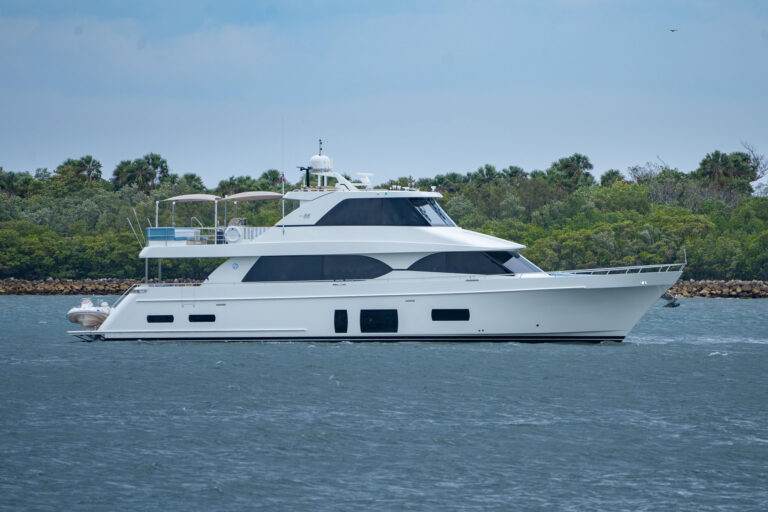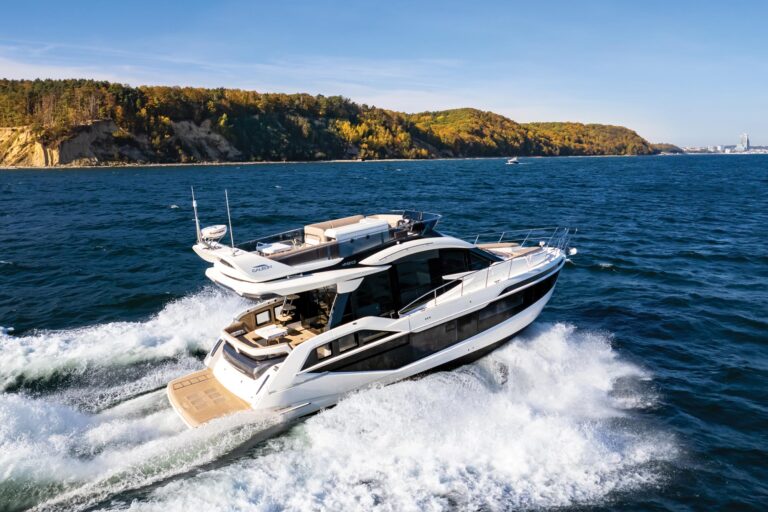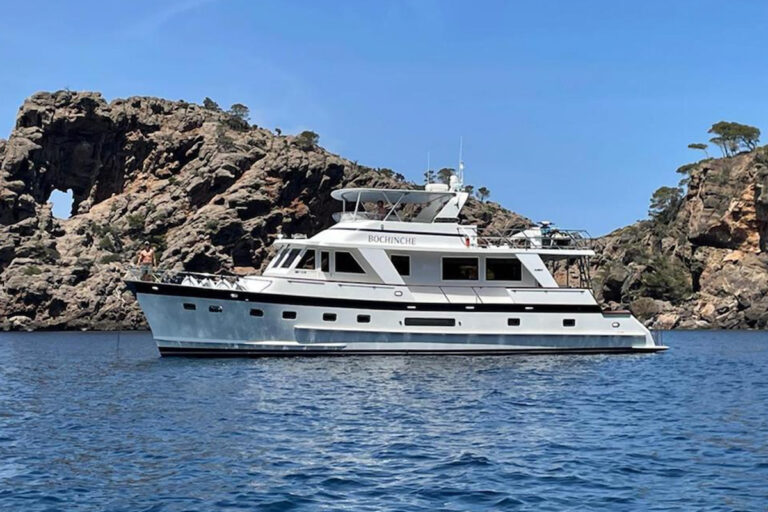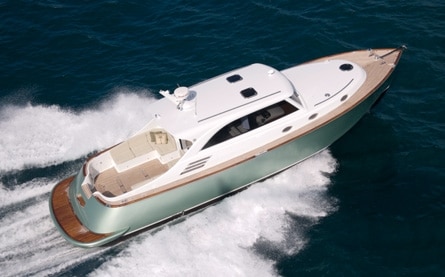
obmay08sol461.jpg
Turkey is obviously no newcomer to boatbuilding-they built the galleons for the first naval victory of the Ottoman Empire seven centuries ago when their fleets ranged far and wide, controlling not only the Mediterranean, but reaching out to North America and the Indian Ocean.
The new Soluna Coupe, however, is an interesting blend of Turkish craftsmanship, the very latest in technology, and a styling that can only be called retro. Clearly drawn with an eye toward the Down East classics, the Soluna is a pretty boat from any angle, with a sweet sheerline more often seen on sailboats than modern powerboats.
That’s no surprise, because Wayne Helms, the president of Soluna Yachts, hails from a long sailing background, while the company’s naval architect, Deniz Dedeal, has a background in classics as well.
After years in the marine business, Helms saw a need for a yacht with timeless styling, built from thoroughly modern materials, and priced to be highly competitive. Since he had represented other European builders, he had good contacts in Turkey, and saw it as a burgeoning center for yacht construction. The Perini Navi megayacht, Maltese Falcon, was recently launched in Turkey and several other megayacht companies have plans to open yards there as well.
Helms chose to take a more proprietary route- starting his own boatyard and drawing on the ready supply of craftsmen already experienced in both high-tech fiberglass and classic joinery. The result is the prototype Soluna Coupe. The second Soluna will be on the East Coast by the time you read this, a third is under construction, and a 58-footer is on the drafting table.
Quite simply, there is no mistaking the Soluna Coupe. The finely drawn bow flares into a chine reminiscent of old PT Boats, with a hard chine running aft to kiss the water about amidships. This wide and flat chine should throw any spray out and away from the hull, keeping the decks and house relatively dry even in a seaway.
At the same time, the topsides roll gracefully into a tumblehome and reverse transom that harkens back to vintage commuter yachts. With pale icegreen topsides (unusual finishes are a hallmark of the Solunas) and teak decks, this is a yacht that you won’t soon forget.
One of the issues important to Helms was to create a low-maintenance yacht: “I wanted it to be use-and-wash,” he says. To that end, all exterior varnished wood except the cap rail has been eliminated.
Where some builders might try to cut corners, Helms hasn’t stinted on the construction details. The Soluna features a hand-laminated hull with blister-resistant vinylester resin, fiberglass frames, and stringers filled with rot-proof foam, as well as vacuum- bagged Divinycell coring in the topsides. The deck and superstructure are also vacuum-bagged using a honeycomb sandwich core, as is the interior furniture. The result is a rugged but lightweight yacht that tips the scales at just 29,000 pounds.
There are a number of creative touches as well, and the first that you’ll notice is the absence of a transom door. Rather than fiddle with an opening door (“They always rattle,” says Helms), the transom has a notch with a pair of built-in teak-planked steps, designed to be easy to step over.
On the prototype, L-shaped seats are forward on each side of the cockpit but the production yachts will have a pair of consoles tucked under the overhang of the coach roof. These will conceal a barbecue grill and a wet bar, making the cockpit a pleasant entertainment area with the settees moved further aft.
Aside from the appealing retro look, the feature I found most striking on the Soluna Coupe was the bright and airy saloon, which is surrounded by large windows and, with double-opening doors aft, can be either enclosed or opened to enjoy a fine day. The custom saloon door, which will be curved on future boats, slid with fingertip pressure and closed with a satisfying thunk.
Our prototype test boat had a teak interior to give it a vintage look. The joinery is impressive, and almost every surface has a curve-some subtle and some obvious. Every piece of wood, from the bulkheads to the locker doors, is carefully book-matched and aligned so the grain is continuous.
A curved settee with a fold-out table for cocktails or dining is to port, and future Soluna Coupes will have an entertainment cabinet with a pop-up TV next to a swivel chair to starboard. To balance the sunny windows, a pair of 16,000-btu a/c units are dedicated to the saloon for ample cooling power.
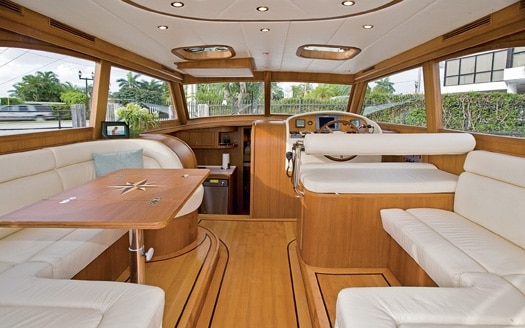
| | |
The skipper has a double-wide bench seat behind a curved, leather-covered dashboard. There is a clear view in all directions including corners aft. The dash was sized for a Raymarine E80 monitor, though future boats will have enlarged versions for the E120 screens. A pair of multi-function Yanmar engine monitors flank the display, and the super-smooth Yanmar shifters are on the dash, as is the joystick for the Max Power bow thruster. The retro theme carries all the way to the wood-and-stainless wheel.
Cooks will be delighted with the galley. Down from the saloon but completely open overhead, it is flooded with light and the chef can still carry on a conversation with guests in the saloon above. All of the appliances are top of the line.
The master cabin fills the bow with an island berth with drawers underneath and a large hanging locker nearby. The drawers throughout the Soluna are self-closing and every locker is wood-lined and finished.
The single head on the prototype has been divided into a shower compartment with a sink to port and a head compartment with a second sink to starboard on future boats. In addition, production yachts will have the guest cabin rearranged to include a pair of berths with a filler to create a queen bed. There’s a surprising amount of room in the guest stateroom, with full headroom and a large hanging locker.
Power for the prototype was a pair of 440-horsepower Yanmar diesels, and future boats will have the 480-horsepower Yanmar 6LY3-ETP diesels. These should give a slight speed increase over the 30-plus-knot top speed on the first boat. We had rough seas in the Gulf Stream, but I was able to confirm that the boat has a very comfortable 26- to 27-knot cruise at about 70-percent power and, at 20 knots, the Soluna Coupe had a fuel efficient 18.1 gph consumption, giving it better than 1 mile per gallon. The standard generator, installed in a sound shield in a lazarette separated from the engine room, is a 9.5-kW Onan that is so quiet you can’t hear it with the saloon doors closed.
As you’d expect, there isn’t much headroom in the engineroom but, the engines are compact, so there’s easy access to their outboard side, and all of the wiring and plumbing was seamanlike and tidy.
To simplify the buying process as well as production, the Soluna Coupe is delivered surprisingly well equipped with a generator, bow thruster, full Raymarine electronics, including radar and autopilot, a sophisticated entertainment package with three TVs, a fire system, Glendinning shorepower reel, trim tabs, full galley appliances, a Lewmar anchor windlass, and a cockpit canopy on tracks. Priced at $795,000 with all this included, the Soluna Coupe is a remarkable value as well as a remarkable yacht. Owners will just have to get used to people saying, “Pretty boat what is she?”
Soluna Yachts, (954) 462-0116; www.solunayachts.com

